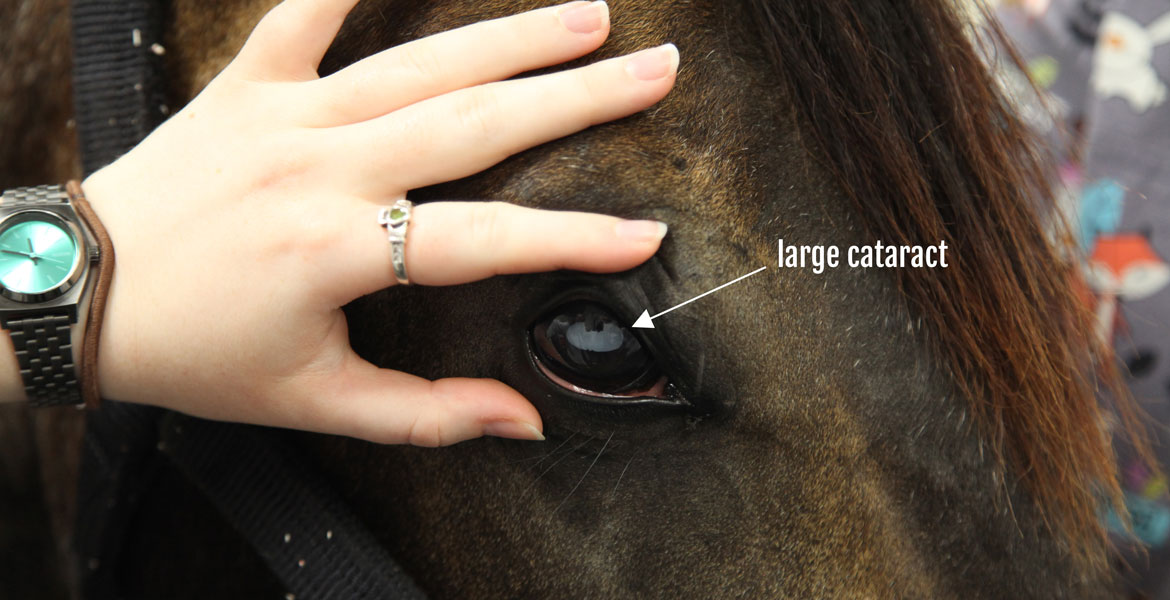
OSU Ophthalmologists Offer Equine Cataract Surgery
Tuesday, December 11, 2018
Thanks to a generous donor, Oklahoma State University’s Center for Veterinary Health Sciences recently acquired a phacoemulsification machine that allows them to perform cataract surgery on horses.
“Right now in Oklahoma we are the only ophthalmologists who are performing cataract surgery in horses,” said Dr. Emily Sharpe, a board-certified ophthalmologist at the Center’s Veterinary Medical Hospital. “While every ophthalmologist will have a phacoemulsification unit, many of these units were developed for human ophthalmology. They can work really well for dogs and in fact, we use the same units that they use in people for cataract surgery in dogs. The trouble with using the same unit in horses is that we need some special attachments because the horse’s eye is so much larger than a dog’s eye or a person’s eye.”
While cataracts in horses are fairly uncommon, Sharpe and her team did have an opportunity to remove a cataract in a yearling colt named Spook.
“When we do see cataracts, the most common reason is chronic inflammation inside the eye,” continued Sharpe. “Some of those horses are not candidates for surgery because there has been damage done to other parts of the eye due to that longstanding inflammation. Less commonly, horses can get cataracts when they are very young, like Spook. They can either be born with these cataracts or they develop cataracts at a young age.
“If a horse has a very small cataract, it may not have any significant impact on their vision and we can just monitor it for progression. But an advanced cataract can cause significant visual deficits and even blindness. And that’s a big deal for a horse because they are a prey species. Even blindness in one eye can significantly decrease the horse’s field of vision. Spook had a large cataract in his right eye that caused complete loss of vision from that eye.”
Sharpe and her team operated on Spook on October 17, 2018, to remove the cataract. The phacoemulsification machine uses ultrasonic energy to break up the cataract while concurrently running fluids into the eye and aspirating those fluids out of the eye along with the cataract that has been broken up.
“His surgery went well and he went home on anti-inflammatory medications and antibiotics,” reported Sharpe. “He came back the following week for a re-check. We recheck them pretty frequently after surgery to make sure that if any complications develop, it’s something we can address quickly and still have the best chance of having a successful outcome. In general, younger horses that have cataracts tend to do better than older horses that have cataracts and undergo cataract surgery. So we are hopeful that he will have a successful outcome.”
Dr. Katelyn Fentiman, another board-certified ophthalmologist on staff at OSU’s Veterinary Medical Hospital, saw Spook for his checkup on October 30, 2018.
“His eye looked very good. His post-operative inflammation was well controlled and he was not exhibiting intraocular pressure elevations, which can occur after surgery,” said Dr. Fentiman. “His owner seemed very happy with his vision and felt that he could see a notable difference in Spook’s behavior when comparing before and after surgery. Spook is still wearing a protective mask. We use the mask for two to four weeks after surgery to ensure that the horse cannot rub the eye while the corneal incision heals.”
“I’m really excited that we are now able to offer full-time ophthalmology services,” added Sharpe. “While cataract surgery in horses is something that we are thankful that we are able to perform, it’s not the most common reason that we see horses for an eye problem. Much more commonly we see horses with problems like corneal ulcers, intraocular inflammation, or even cancer around the eye. These diseases can be vision threatening. And unfortunately in horses, these diseases can also progress very rapidly. So it’s important that any time horse owners see that their horse is having an eye problem that they get the horse seen by a veterinarian as soon as possible. I hope horse owners and veterinarians seeing horses with eye problems know that we are here to serve as a resource for any ocular emergencies or complicated cases.”
For more information on ophthalmology services available at Oklahoma State University’s Center for Veterinary Health Sciences, visit the Ophthalmology webpage or call (405) 744-7000, extension 1 and ask for ophthalmology.
Meet the Ophthalmologists
Dr. Emily Sharpe grew up in Broken Bow, Oklahoma, and attended Oklahoma State University earning her DVM degree in 2013. She completed her board certification in ophthalmology and became a diplomate of the American College of Veterinary Ophthalmologists in 2017.
“I chose ophthalmology because as veterinarians we have to learn about all the different systems and about all these different species. For me, ophthalmology just clicked better than any other subject,” explained Sharpe. “I was excited about learning about eyes and I wanted to learn everything I could about this field. Another benefit for me is that I don’t have to choose which species I work on. I get to work on any animal that has eyeballs.”
Dr. Katelyn Fentiman grew up in Monument, Colorado, and earned her DVM degree from Kansas State University in 2014. She became a diplomate of the American College of Veterinary Ophthalmologists in 2018.
“For me, ophthalmology offered all of the things that I love most about veterinary medicine,” said Fentiman. “It combines medical management and surgery and allows me to work on small and large animal patients. It also gives me the opportunity to treat conditions that truly affect the life of the animal by protecting vision and comfort.”
